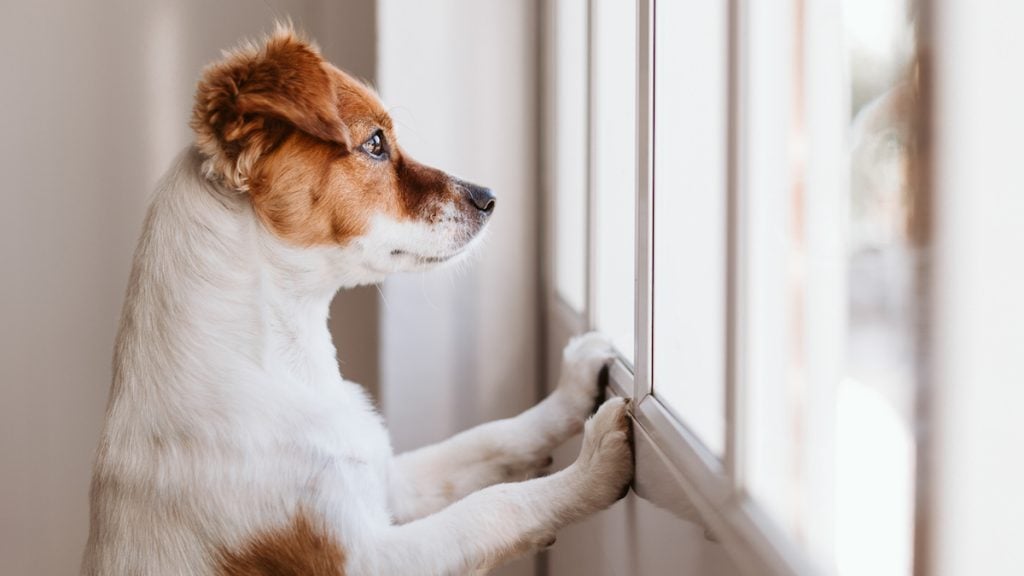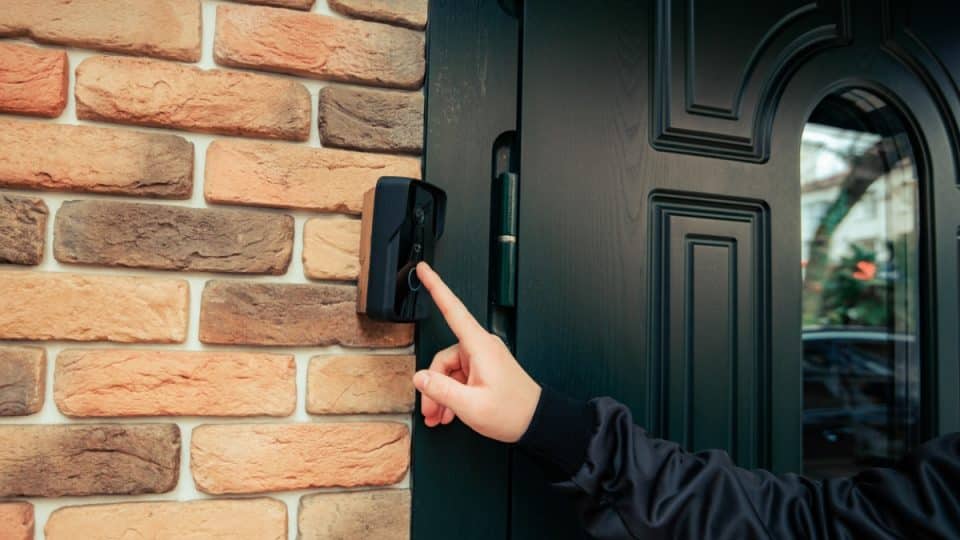- Not a substitute for professional veterinary help.
Dinner parties, trick-or-treaters, or package delivery can all be downright scary for dogs. Think of it from their perspective: a knock at the door, a bell ring, and chances are that a stranger is about to encroach on their territory. (On Halloween, it might even be a bunch of small people in masks!)
Read on to learn why dogs bark at the doorbell and how you can help change the behavior. (And if your dog is really having a hard time, like, say, on Halloween or a big party you’re throwing, you can always give him a break with a local pet sitter in a quieter neighborhood.)

iStock/omersukrugoksu
Why Do Dogs Bark at the Doorbell?
Dogs who are sensitive to noises (who can blame them with that hearing ability!) can be easily startled by the doorbell or a knock. Some dogs have learned that scary things happen after a knock at the door or a doorbell ring, like a stranger entering the home. Other dogs can be simply frustrated because they want to see what’s on the other side immediately! Dogs always behave for a reason, and it’s important to find the “why” before we even attempt to change the behavior—our approach may differ depending on the underlying cause.
Here are some signs that your dog is in distress when they’re barking at the door:
- Ears pulled back, pupils dilated, skin tight around the face (photo reference)
- Tail low and tucked between legs or high and rapidly wagging (photo reference)
- Shaking, pacing, or spinning
- Unable to focus
- Won’t take food or things they usually enjoy
- Head turning away and whale eye (photo reference)
- Excessive panting (when not hot) with a wide, pulled back mouth (clown mouth)
If your dog exhibits any of these behaviors when the doorbell rings we recommend you seek a professional force free trainer to help you with a treatment plan to get your dog feeling safer with the sounds of the front door.
Not all doorbell barkers are fearful or anxious! Some dogs learn that the doorbell predicts the arrival of their favorite guest, so they get extra excited.
You can tell your dog is excited if they:
- Run straight to the door when it rings
- Wag their tail in a circular motion or from side to side in the middle position
- Have full-body wags (a classic sign of doggy happiness)
- Run back and forth excitedly between you and the door
- Bark intermittently vs a constant and escalating bark
Learning how to read your dog’s body language will help you manage their reaction to the doorbell.

iStock/xuanhuongho
How to Prevent Your Dog From Barking at the Door
Sometimes we can solve an issue by using clever hacks that bring immediate relief to both human and dog. Plus, if your dog has a regular routine of barking at the door, we must stop the rehearsal of the behavior before we can even begin to teach them what we want them to do instead. Proactive prevention is key.
For example:
- Put up a sign for deliveries and unplanned visitors and tell your friends and family to text when they arrive.
- If you have windows near your door, close the blinds or put up a translucent film to lower your dog’s chance of visual stimulation.
- Put up a barrier to block access to any window or door your dog usually barks at.
- If your dog is sound sensitive, use a box fan, music, or a white noise machine to diffuse front door noise.
What to Do When Your Dog Barks at the Door
Teaching your dog what you’d like them to do when someone’s at the door takes time and consistency.
In the meantime, when your dog barks at the doorbell:
- Never yell. Yelling over your dog’s barking simply adds to the noise and can scare them, creating a negative association with the front door—and you.
- Calmly grab a handful of treats, say “go find it!” and throw them away from the door (ideally behind a barrier). This encourages your dog to move away from the door, and it gets their nose working, which decreases heart rate. Plus, if you start doing this on a regular basis after a few alert barks, your dog learns they can still do their dogly duty of alerting you of something at the front door, but it pays better to let you take it from there.
- Answer their question. If we think of our dogs’ barks as attempts to communicate and ask questions about their environment—which they often are, then simply talking your dog through an event can have a huge impact, create predictability, and ease the big feelings they’re having. It works like this: When your dog alerts to the front door, say “yep, our friend is here, we’re safe.” Say this every time and eventually your dog learns that the front door is boring and predictable. (See author and dog trainer’s Kim Brophey’s “Mr. Rogers” hack about this).

Eva Blanco/iStock
How to Teach Your Dog to Stop Barking at the Doorbell
Practice these techniques twice a day for 5-10 minutes each (that’s it!) when you’re not expecting company. Remember, it takes time to build new behaviors, so don’t expect your dog to “know” what you’re asking of them until everyone in the home has practiced consistently.
Pick a technique and stick with it, here are my favorites:
- Thanks for Barking 2.0 by Kiki Yablon, KPA-CTP, CPDT-KA. In this technique, you’ll thank your dog for barking and then reward them for it! This eventually leads to the first step in the process (the barking!) to become more perfunctory and in some cases even drop off completely.
- Pair the cues of someone being at your door—doorbell ring, knock—with something your dog loves, like food, a special toy, or play! Ring the bell or knock, then immediately give them their special treat. Practice this with consistency and pretty soon, your pup will be coming to find you for their reinforcement when visitors arrive!
- Use Kim Brophey’s Off-Duty Hack. Let your dog know they’re “off-duty” by setting them up behind a barrier with something enriching and long-lasting to work on, like a frozen stuffed Kong or marrow bone. If your dog is excited to see guests, let them out to greet after everyone is settled. If your dog is fearful or anxious, have them hang in their safe zone the whole time.
With a combination of prevention and training, you can help your dog learn to love the doorbell, or at least, ignore it.



